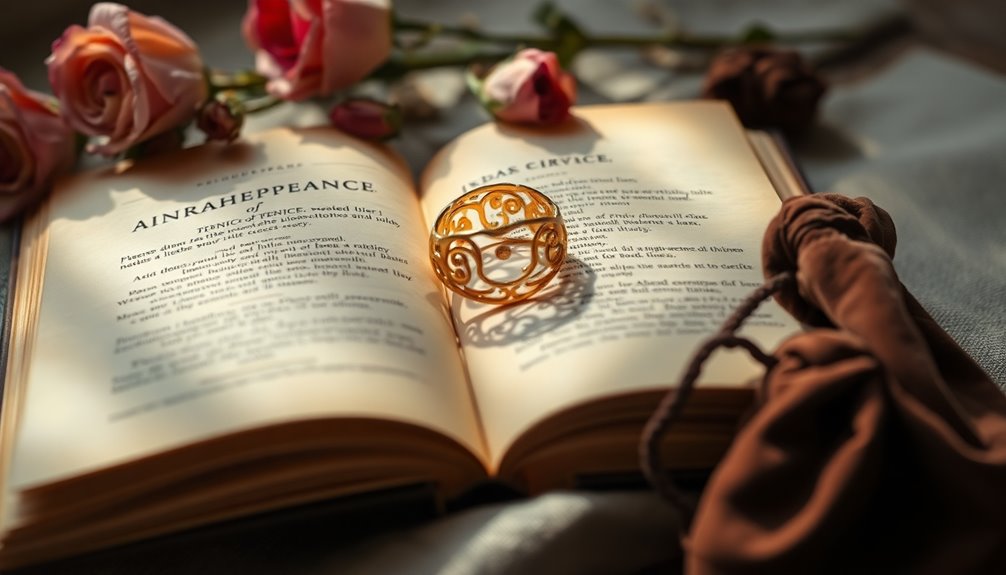Walker uses symbolism to bring her stories to life, especially through items like quilts. These quilts represent family history and the connection to ancestors. Each stitch tells a story, showing the importance of heritage. Characters like Mama and Dee highlight different views on culture. Mama sees quilts as practical treasures, while Dee values them for their looks. This clash shows the struggle between old and new ways of thinking. Walker's symbols also encourage you to think about your own identity and cultural roots. Exciting themes unfold, inviting you to discover more about her powerful messages!
Key Takeaways
- Walker uses quilts as symbols of family heritage, illustrating the connection to ancestry and the importance of preserving cultural memory.
- Characters like Mama and Dee represent contrasting views of heritage, highlighting the tension between traditional values and modern interpretations.
- The conflict over the quilts reflects broader cultural identity struggles within the African-American community, showcasing generational rifts and differing perspectives.
- Symbolism in the story engages readers in exploring deeper cultural dilemmas, prompting reflection on the complexities of identity and heritage.
- Objects like quilts serve as catalysts for character development and thematic exploration, emphasizing the tangible links to personal and collective history.
Symbolism in Walker's Writing

In Alice Walker's writing, symbolism serves as a powerful tool to deepen our understanding of her characters' connections to their heritage. One of the most striking symbols in her stories is the quilt. It represents not just family history, but also the cultural conflicts between characters like Dee and Mama. While Dee sees the quilt as an object of beauty, Mama feels a deep emotional connection to it, seeing it as a part of her identity and heritage.
Clothing also plays a significant role in Walker's symbolism. Dee's vibrant outfits reflect her individualism, showcasing her desire to stand out. In contrast, Mama's practical dress signifies her hardworking nature and her ties to family legacy. This contrast highlights the struggle between modern values and traditional beliefs.
Objects like the butter churn symbolize love and labor from previous generations. They represent the practical value that Mama places on her heritage, contrasting with Dee's more superficial view.
Walker critiques how cultural artifacts can be reduced to mere symbols, instead showing them as vessels of identity. Through these symbols, you can see how deeply characters connect with their roots, revealing rich layers of meaning in their lives.
Characters and Their Symbolic Meanings
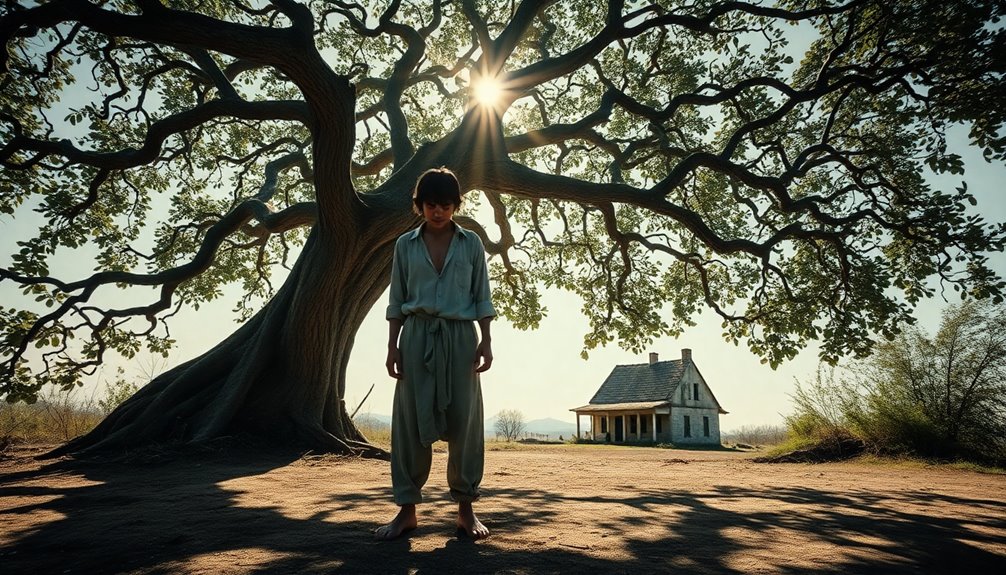
Alice Walker's characters each embody distinct symbolic meanings that reflect broader themes of heritage and identity. In her story, Mama, Dee, and Maggie reveal different values and perspectives about their family's history.
- Mama symbolizes the deep connection to ancestry, valuing practicality over aesthetics.
- Dee represents a modern, superficial understanding of heritage, focusing on the looks of cultural artifacts.
- Maggie shows resilience and a quiet love for her family's past.
Mama's emotional attachment to the quilts illustrates her belief that heritage is about lived experiences and struggles. She wants to pass these quilts down as functional heirlooms, filled with memories and stories.
In contrast, Dee views the quilts as mere decorative items, showcasing her disconnect from their true meaning.
Maggie stands in the middle, quietly honoring her family's history while feeling insecure. Her character reminds us that identity is often shaped by both strength and vulnerability.
Through these characters, Walker invites you to think about what heritage truly means. She encourages a deeper appreciation for your roots and the values that shape your identity.
Each character's journey enriches the story, highlighting the importance of understanding where you come from.
The Role of Quilts in Heritage
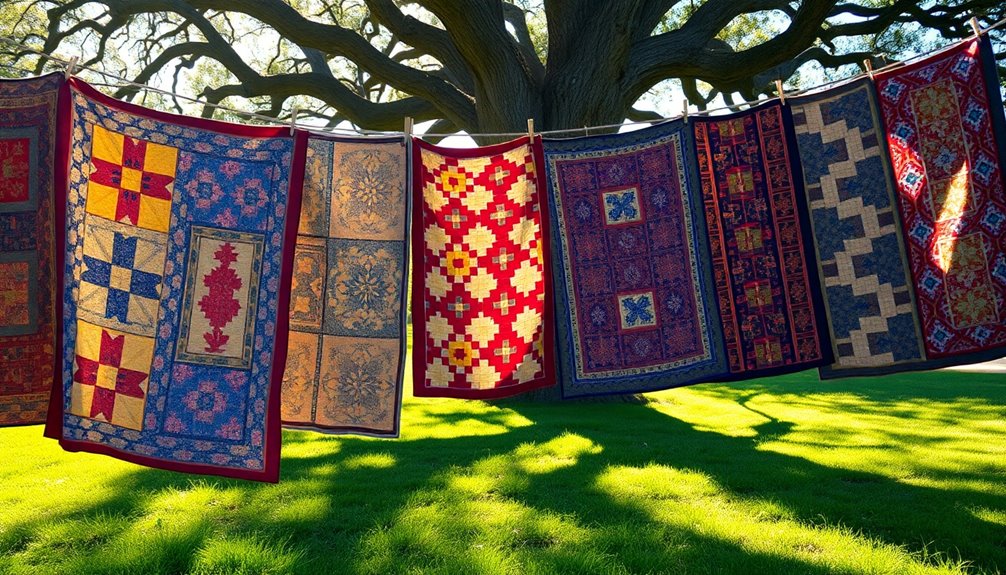
Quilts serve as powerful symbols of heritage in Walker's "Everyday Use," weaving together the stories and struggles of past generations. They embody the family's history, connecting you to your ancestors through every stitch. Mama views these quilts as treasures meant for practical use, while Dee sees them only as beautiful decorations. This difference creates conflict, highlighting their unique perspectives on cultural significance.
Here's a quick look at the role of quilts in this story:
| Aspect | Description |
|---|---|
| Symbolism | Quilts represent family heritage. |
| Practical Use | Mama believes they should be used. |
| Cultural Significance | Different meanings for Dee and Mama. |
| Memory | Each quilt tells a unique story. |
| Identity | Quilts connect characters to their roots. |
The act of passing quilts to Maggie shows the continuity of family history and the importance of memory. It's about keeping the legacy alive. In this way, quilts help define identity and remind you that your heritage is both a story and a living part of your daily life.
Conflict Over Cultural Identity

Cultural identity often sparks heated conflicts, especially in Walker's "Everyday Use," where the struggle over the quilts symbolizes deeper generational divides. The quilts represent cultural heritage, showcasing the family's rich history. However, Mama and Dee see them differently, leading to a significant conflict.
Consider these points:
- Traditional values: Mama values the quilts for their sentimental value and connection to family.
- Modern interpretations: Dee wants the quilts as art, ignoring their practical purpose.
- Generational rifts: This disagreement highlights the clash between old and new ways of thinking about identity.
Dee's desire to take the quilts for decoration shows her detachment from their real meaning. She views them merely as beautiful objects, unlike Mama, who treasures their everyday use and emotional connections.
This tension around the quilts is a powerful symbol of the broader conflict within African-American communities about cultural identity. Walker encourages you to think about how we each value our heritage.
Do we see our past as something to display, or do we embrace it in our daily lives? This reflection makes "Everyday Use" an exciting exploration of identity and legacy.
Objects as Reflections of Self
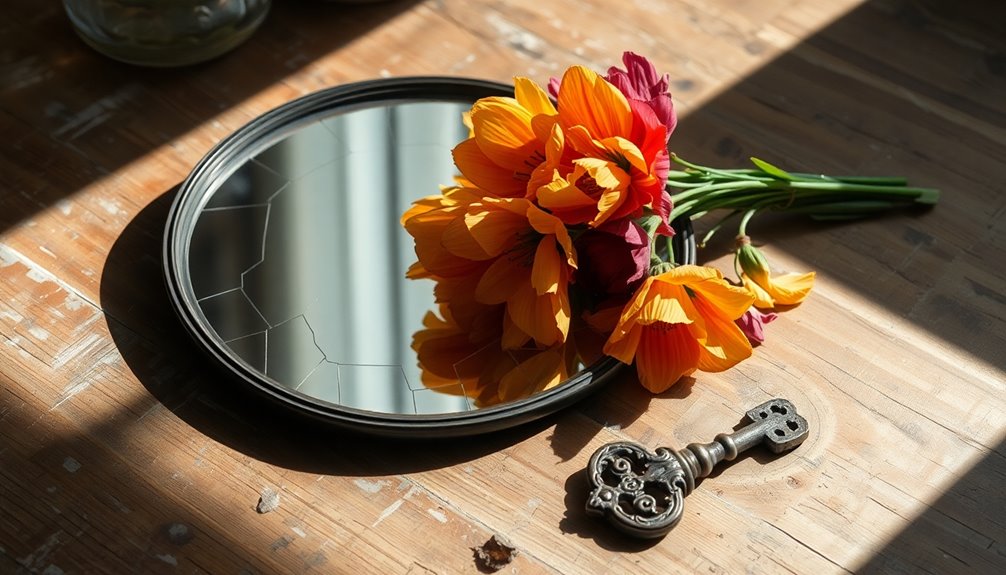
In "Everyday Use," Walker crafts a vivid narrative where objects serve as mirrors reflecting the characters' identities and values. The quilts symbolize family heritage, showing Mama's love for tradition and practical use. To her, these quilts are treasures filled with memories and labor from generations past.
On the other hand, Dee sees the quilts as fancy artifacts, emphasizing her modern identity and disconnect from their true meaning. Dee's loud clothing also serves as a reflection of her assertive character, contrasting sharply with Mama's simple, hardworking attire. This difference highlights how each character views their heritage.
The butter churn stands as another powerful symbol, representing the love and effort of those who came before, while Mama appreciates it for its everyday function. Even the yard, lovingly prepared for Dee's visit, shows Mama's connection to her roots. It reflects her desire for a space that honors her identity and heritage.
Walker skillfully uses these objects not just as physical items, but as storytelling devices that reveal deeper meanings about character and tradition, making the narrative rich and engaging for readers. Additionally, the importance of fire safety protocols in maintaining a safe environment parallels the characters' need to preserve their heritage.
Themes of Tradition vs. Modernity
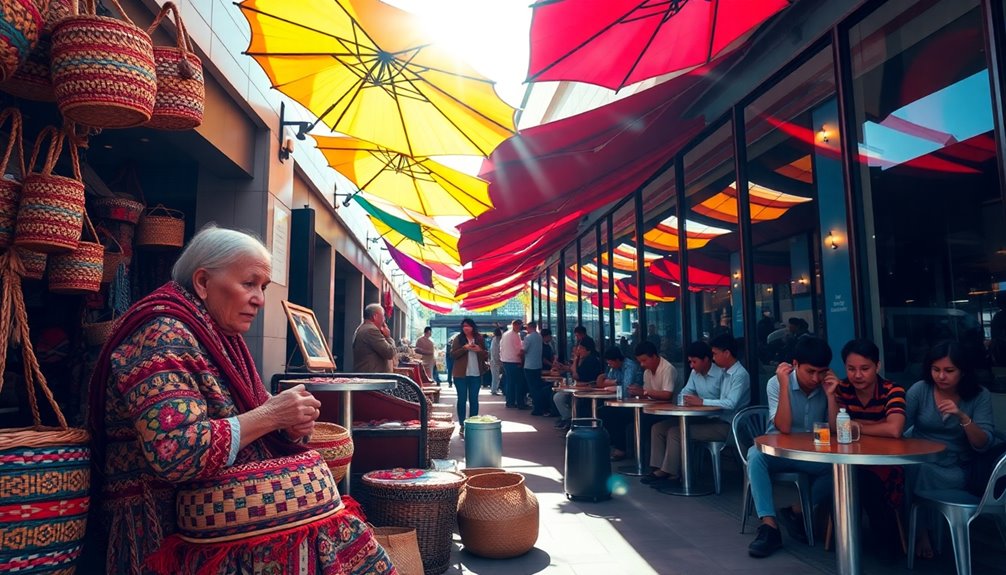
In "Everyday Use," you see a fascinating clash between holding onto traditions and embracing modern ideas.
Mama treasures the quilts for their practical use, while Dee views them as beautiful objects to display.
This conflict shows how different generations can see culture in unique ways, making you think about what heritage really means to you.
Heritage Preservation vs. Aesthetic Appreciation
Exploring the tension between heritage preservation and aesthetic appreciation reveals deep-rooted conflicts in understanding cultural significance. In Alice Walker's "Everyday Use," Mama's view of the quilts as symbols of family history clashes with Dee's desire to display them as art. This contrast highlights how differing values shape our connection to heritage.
You might think about:
- Heritage Preservation: Keeping family traditions alive, like using quilts for warmth and connection.
- Aesthetic Appreciation: Viewing items for their beauty, as Dee does when she wants to hang the quilts.
- Cultural Significance: Understanding the deeper meaning behind objects, like the stories woven into each quilt.
Mama sees these quilts as more than just pretty pieces; they're a tangible link to the past. Each fabric swatch tells a story of family resilience. Dee's modern approach risks losing this connection. Additionally, the importance of emotional regulation in understanding how family dynamics influence our connection to heritage cannot be overlooked.
Through this conflict, Walker teaches us about tradition versus modernity. She encourages readers to value heritage preservation over mere aesthetic appreciation, showing that true cultural significance lies in understanding and honoring our roots.
It's a joyful reminder of the importance of family values and the stories that shape who we are.
Generational Perspectives on Culture
The clash between Mama and Dee in "Everyday Use" showcases how generational perspectives shape our understanding of culture, particularly the tension between tradition and modernity. Mama represents tradition, holding onto family values and the stories tied to their heritage. For her, the quilts symbolize this history, meant for practical use and connection to loved ones.
In contrast, Dee seeks a modern identity. She changes her name to "Wangero Leewanika Kemanjo," trying to embrace a new perspective, but this also shows her disconnection from her family's past.
This conflict between Mama and Dee highlights a broader struggle in society: preserving cultural heritage while adapting to contemporary ideals. Dee views the quilts as mere decorative objects, stripping them of their significance, while Mama treasures them as part of her identity and family legacy.
Through Maggie, Walker emphasizes the quiet strength of tradition, as she stands as a link between these conflicting views. Ultimately, the story encourages you to reflect on your own relationship with culture, identity, and the importance of understanding one's roots, reminding you that both tradition and modernity can coexist in meaningful ways.
Practicality Versus Symbolic Value
Two distinct perspectives emerge in "Everyday Use" as Walker explores the conflict between practicality and symbolic value in heritage. You see Mama valuing the quilts for their practical value, while Dee sees them as just beautiful artifacts. This difference highlights the clash between tradition and modernity in their family.
Consider these points:
- Mama cherishes the quilts because they connect her to family history, showing love and tradition.
- Dee wants the quilts for their symbolic value, wanting to display them rather than use them for warmth.
- This disagreement illustrates cultural struggles within the African-American community, where identity and heritage can create rifts in family relationships.
Walker's use of symbolism helps you understand how the characters relate to their heritage. The quilts represent more than just fabric; they tell stories of family and tradition.
Mama's attachment to the quilts shows how important it's to preserve practical traditions. In contrast, Dee's view reflects a modern interpretation of heritage.
This conflict captures how different perspectives on identity can shape family bonds, making "Everyday Use" a thought-provoking exploration of our connections to the past.
Impact of Symbolism on Readers
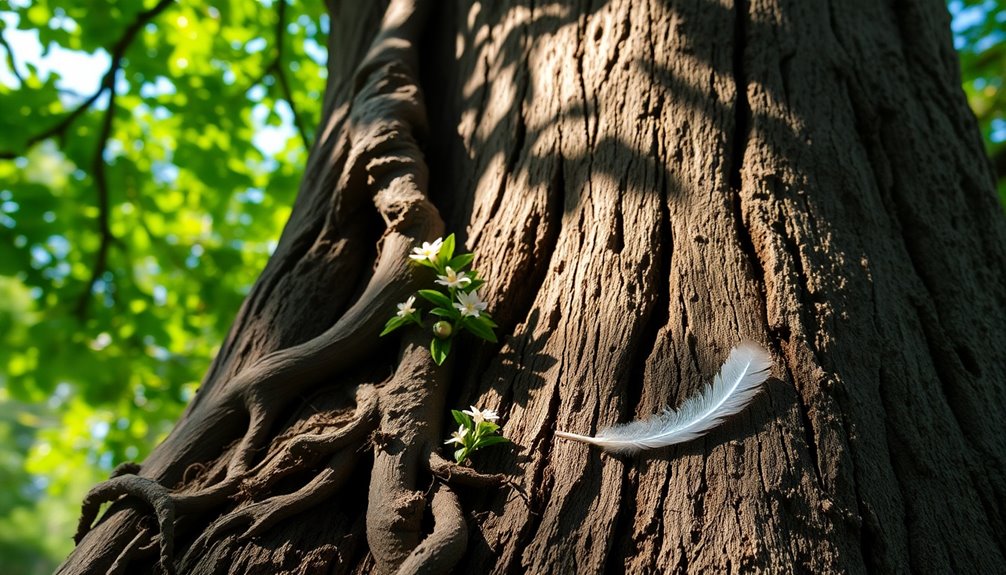
When you read Walker's stories, you can really see how symbolism helps you understand the characters better.
For example, the quilts and the yard show different ideas about culture and identity, making you think about what these objects mean to each character.
This journey into symbolism invites you to explore the cultural conflicts and appreciate the deeper messages in the story!
Enhancing Character Understanding
While symbolism weaves through Walker's narrative, it markedly enhances your understanding of the characters' complexities. Each symbol in the story offers you a glimpse into the characters' hearts and minds, showcasing their unique relationships with heritage and identity.
- The quilts represent family history, filled with stories and love from generations past.
- The butter churn symbolizes hard work and dedication, reminding you of the labor of previous generations.
- Dee's name change highlights her detachment from her roots, prompting you to think about cultural appropriation.
These symbols don't just decorate the story; they deepen its meaning. Mama's connection to tradition is evident in the yard she meticulously prepares for Dee's visit. This yard is more than just land; it holds emotional significance and reveals Mama's bond with her heritage.
In contrast, Dee's superficial love for cultural artifacts shows her misunderstanding of what it means to honor her past.
Through Walker's rich use of symbolism, you gain valuable insights into the characters' struggles, joys, and the thematic depth of their lives. It helps you see that heritage isn't just something to admire; it's something to live and cherish.
Engaging Deeper Analysis
Symbolism in Walker's work profoundly impacts you as a reader, inviting you to engage with the characters and their cultural dilemmas on a deeper level. Through rich symbols like quilts, you explore the connection between family heritage and cultural identity. You see how these characters, especially Mama and Dee, struggle with the themes of tradition versus modernity.
Mama's practical attachment to the quilts shows a deep respect for her heritage. In contrast, Dee's aesthetic appreciation highlights a more modern view of material culture. This contrast prompts you to reflect on your own understanding of heritage.
Walker uses vivid imagery and metaphorical language, drawing you into the emotional struggles of the characters. You can feel their triumphs and challenges as they navigate their identities. The symbolism makes you think critically about the complexities of African-American life, revealing how the past influences the present.
Reflecting Cultural Conflicts
Through the lens of Walker's symbolism, readers encounter the cultural conflicts that shape the characters' lives and identities. The quilts in "Everyday Use" represent more than just fabric; they embody the family's rich heritage and the struggles they've faced together.
You'll notice how Mama clings to the quilts, feeling deeply connected to their past. In contrast, Dee sees them as trendy artifacts, which creates emotional tension and highlights generational rifts within the family.
This clash of values invites you to think about:
- The meaning of heritage and how it shapes identity.
- The difference between true appreciation and cultural appropriation.
- The impact of these conflicts on family relationships.
Walker's use of symbolism isn't just clever storytelling; it encourages you to reflect on your understanding of culture and identity. The emotional tension surrounding the quilts pulls you into the narrative, making you consider how different perspectives can coexist.
Frequently Asked Questions
How Does Walker Use Symbolism to Reveal?
Walker uses symbolism to reveal deep connections between characters and their heritage.
For example, the quilts show how Mama values family history, while Dee sees them as mere decoration.
The butter churn represents the hard work of past generations, highlighting Mama's pride.
Maggie's shy demeanor, compared to a "lame animal," reflects her low self-esteem.
All these symbols help you understand their different views on what heritage truly means and how it shapes their lives.
What Are Some Examples of Symbolism in Everyday Use by Alice Walker?
In "Everyday Use," several symbols stand out. The quilts represent the family's heritage, blending past and present. They show how Mama values practicality over Dee's desire to display them as art.
The butter churn symbolizes the hard work of Mama's ancestors, emphasizing love and tradition. Dee's name change highlights her disconnect from her roots.
Finally, the yard reflects Mama's connection to the land, showcasing her deep respect for family and culture.
Which Statement Best Describes What the Symbolism in This Passage From Everyday Use by Alice Walker Reveals About the Narrator's Character?
The symbolism in this passage reveals that the narrator, Mama, deeply values her family's history and traditions.
You see her connection to the quilts and the yard, showing how much she cherishes her heritage.
Mama sees Maggie as strong yet vulnerable, which highlights her protective nature.
In contrast, her daughter Dee's view feels distant and superficial.
This difference shows Mama's grounded understanding of what true cultural identity means, making her character rich and relatable.
What Type of Symbolism Do You Think Quilts Could Represent in This Text?
In "Everyday Use," quilts can represent family heritage and connection.
They're like a treasure chest filled with memories, showing where you come from. Imagine every stitch telling a story of love, struggle, and pride.
These quilts aren't just pretty—they're meant to be used! They remind you that your past is alive, carrying lessons and traditions.
Conclusion
In Walker's world, symbols are like colorful threads weaving a beautiful quilt of stories. Each character and object tells a tale, showing us the importance of our roots and who we are. Just like a quilt, the mix of old and new shapes our identity. As you explore Walker's work, you uncover layers of meaning that spark joy and reflection. So, immerse yourself and let these symbols guide you on a delightful journey of understanding and connection!







